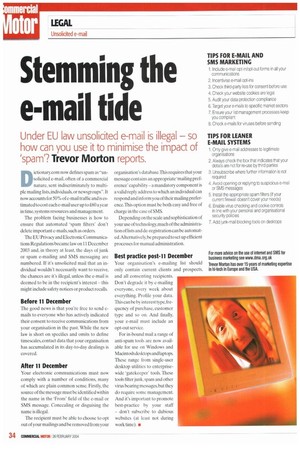Stemming the e-mail tide
Page 34

If you've noticed an error in this article please click here to report it so we can fix it.
Under EU law unsolicited e-mail is illegal — so how can you use it to minimise the impact of
ispamf? Trevor Morton reports.
Dictionary.corn now defines spam as "unsolicited e-mail, often of a commercial nature, sent indiscriminately to multiple mailing lists, individuals, or newsgroups-. It now accounts for 50% of e-mail traffic and is estimated to cost each e-mail user up to £60a year in time, systems resources and management.
The problem facing businesses is how to ensure that automated 'spam filters' don't delete important e-mails,such as orders.
The EU Privacy and Electronic Communications Regulations became law on 11 December 2003 and, in theory at least, the days of junk or spam e-mailing and SMS messaging are numbered. If it's unsolicited mail that an individual wouldn't necessarily want to receive, the chances are it's illegal, unless the e-mail is deemed to be in the recipient's interest this might include safety notices or product recalls.
Before 11 December
The good news is that you're free to send emails to everyone who has actively indicated their consent to receive communications from your organisation in the past. While the new law is short on specifics and omits to define titnescales, contact data that your organisation has accumulated in its day-to-day dealings is covered.
After 11 December
Your electronic communications must now comply with a number of conditions, many of which are plain common sense. Firstly, the source of the message must be identified within the name in the 'From' field of the e-mail or SMS message. Concealing or disguising the name is illegal.
The recipient must be able to choose to opt out of your mailings and be removed from your organisation's database.This requires that your message contains an appropriate 'mailing preference' capabilitya mandatory component is a valid reply address to which an individual can respond and inform you of their mailing preference.This option must be both easy and free of charge in the case of SMS.
Depending on the scale and sophistication of your use of technology.much of the administration of lists and de-registration can be automated.Alternatively,be prepared to set up efficient processes for manual administration.
Best practice post-11 December
Your organisation's e-imtiIing list should only contain current clients and prospects. and all consenting recipients. Don't degrade it by c-mailing everyone, every week about everything. Profile your data. This can be by interest type, frequency of purchase, customer type and so on. And finally, your e-mail must include an opt-out service.
For in-bound mail a range of anti-spam tools are now available for use on Windows and Macintosh desktops and laptops. These range from single-user desktop utilities to enterprisewide 'gatekeeper' tools. These tools filter junk. spam and other virus bearing messages, but they do require some management. And it's important to promote best-practice by your staff don't subscribe to dubious websites (at least not during work time). •






























































































































































































